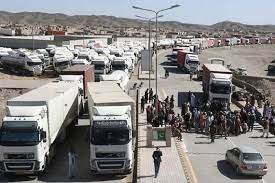Pakistan shares a long border of some 909 km with Iran ,its West. Districts Chaghi, Washuk, Panjgur, Kech, and Gwadar of the Balochistan province of Pakistan have adjoining borders with Iran. It is estimated that over a million Pakistanis directly, and almost the same number of Pakistanis indirectly, depend on border trade, or rather smuggling on that border with Iran. It is easy to find Iranian beverages, petrol and diesel, cooking oil, sweets, snacks, and dairy products in more than half of Balochistan, even in the provincial capital Quetta, and especially contiguous Baloch areas in the province. The contiguous districts of the province even get electricity from Iran, as these districts have yet to be connected with Pakistan`s national grid. In short, the livelihoods of a great number of Pakistanis are directly or indirectly dependent on this border.
Therefore, there is a need to regularize and increase border trade with Iran and make easy movement of human capital possible. This article aims at exploring and recommending a way forward.
For a long part of its 75 years of history, Pakistan remained grappling with the choices in its foreign policy to maintain a balance between the Iran and Saudi Arabia. Pakistan’s population is over 75 percent Sunni Muslim, causing a tilt in its public opinion in favor of the Kingdom. However, it is also a fact that no nation on earth has the choice to pick and choose its neighbours, which has always nudged the people sitting in Islamabad to opt for a wiser and balanced approach between Iran and the Kingdom. For, foreign relations cannot be taken for granted and keep changing depending upon vital national interests.
Since the China-been brokered rapprochement between Iran and the KSA has recently reached, choices have ultimately got better for Islamabad. Stakeholders and policymakers in Pakistan now should benefit most from this rapprochement. China, unlike the USA, may not get offended if Pakistan goes for more and easier border trade and cooperation with Iran. Secondly, the KSA is also unlikely to get offended by such cooperation anymore, therefore options should be explored to increase trade and cooperation with Iran.
Possible options can be as follows. A great number of people living in Balochistan near the Iranian border often trade through the Taftan border. Certain checkpoints with advanced CCTV cameras and technologically well-equipped computer systems should be built for more trade and easy human capital movement across the border. Locations for such advanced-feature checkpoints can be Taftan in District Chaghi, Mashkel in District Kharan, Grawag in District Panjgur, Mand in District Turbat, Jiwani and Gabd in District Gwadar of Balochistan. Checkpoints that are already functional should be upgraded. Proper checks and balances and strict accountability will make it smooth for the people living on both sides of the border to trade easily.
However, American sanctions on Iran cannot be nullified but can be managed intelligently, therefore, barter trade can be a potential option to consider in this regard. There are already such memorandums of understanding (MoUs) between Pakistan and Iran that ask for barter trade between the two, so those need to be implemented and more such MoUs should be concluded for increasing the trade volume between the countries. There are already such instances where Iran has explored barter trade arrangements with India, Russia, Thailand, and Turkiye.
With the China-brokered rapprochement between Iran and Saudi Arabia, new options for cooperation, trade, easy movement of human capital, and tourism have opened for Pakistan and Iran both. They can open more checkpoints across the border and install and use technologically advanced gadgets and systems to make convenient trade between them.
The recent visit of Pakistan`s Prime Minister Shehbaz Sharif to Iran, his meeting with the Iranian President Ebrahim Raisi, and their joint inauguration of a marketplace and a power transmission line along the Pak-Iran border is a good starter to boost trade and energy cooperation between both countries. As already stated by the Iranian leader during Shehbaz`s visit, Iran is ready to deepen energy cooperation with Pakistan. His words, “Today, both countries see the border as an opportunity and not a threat,” also sound welcoming and signal more cooperation between the two countries. Because in the past, both countries at times have blamed each other for harbouring militant groups or showing reluctance to act against them that were operating across the border against either Iran or Pakistan.
For easy movement of human capital across the border and for increasing tourism between the two countries, it is essential to deal with a major ideological fault line that is visible in both countries. For instance, a great number of ethnic Hazara Shias live in the outskirts of Quetta and there is almost no connection between the Shia and Sunni population of the city. Unfortunately, this sectarian divide is now quite visible in many parts of Pakistan, where the Shias and Sunnis feel threatened by each other. The other side of the coin is not good either, as there are instances of harassing the Sunni population in Iran, also harassing Pakistani passport holders, and calling them names to make them feel inferior to Persians.
For such reasons, it is important to manage this sectarian fault line, which is possible by following a specific course of action. For instance, Pakistani passports ought to be respected in Iran, and arrangements should be made between the officials of both states for this purpose. Secondly, the Shia-Sunni divide card should not be allowed to be played by the clergy nor by any political party nor any religious group. The law-enforcing agencies in Pakistan, as well as Iran, should make it clear that those who play this card will be punished as per the law of the land. Most importantly, efforts should be made to end Shia-Sunni segregation in Pakistan, and ideas that are common between both sects like respect for the Holy Prophet Muhammad (PBUH) and the teachings of the Holy Quran should be used as a bridge to bring them closer. The slogan of the Single National Curriculum can possibly do that. Also, many of their cultures not only resemble but are exactly the same, and should be promoted.
With the China-brokered rapprochement between Iran and Saudi Arabia, new options for cooperation, trade, easy movement of human capital, and tourism have opened for Pakistan and Iran both. They can open more checkpoints across the border and install and use technologically advanced gadgets and systems to make convenient trade between them.
However, they need to counter the sectarian divide that both states` populations face to enhance tourism and increase cooperation between their citizens, mechanisms for more interaction between Pakistanis and Iranians to increase tourism and easy movement of human capital can be discussed between the two governments. Such policies in the long run will not only benefit Pakistan and Iran, but also the entire region.























